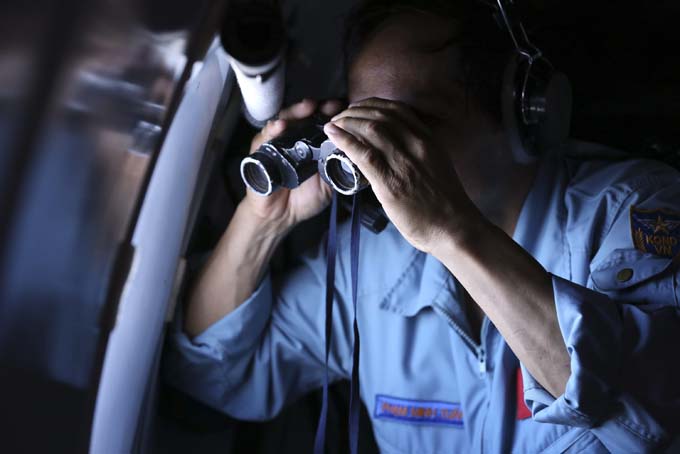
The disappearance of Malaysia Airlines Flight 370 has generated dozens of theories on where it is now, from the Indian Ocean to the South China Sea, and how it vanished. Here’s a rundown of what we know and what we don’t, along with clues and theories about what happened to the Boeing 777 jetliner:
THE WHERE:
— LAST CONTACT: Flight MH370 last communicated with air traffic control on March 8 east of Malaysia, and that area of the South China Sea between Malaysia and Vietnam initially was the focus of the search. Many experts assumed the plane had suffered a sudden catastrophic event because pilots didn’t alert ground control before it vanished from radar screens.
However, nothing was found there or farther north in the Gulf of Thailand. Within 18 hours, Malaysian authorities said they believed the plane may have tried to turn back, and search planes and vessels were sent to the Strait of Malacca, on the other side of Malaysia.
— EXPANDED SEARCH: The search moved into the Indian Ocean on Friday after U.S. officials said the plane had sent signals to satellites for hours after its last contact with air traffic control. The U.S. Navy moved one of its ships in the Strait of Malacca. India has said it is searching hundreds of small, uninhabited islands in the Andaman Sea more than 700 miles west of the plane’s last known position.
— SEISMIC REPORT: A Chinese university says it detected a seismic event in a “non-seismic zone” near the spot in the South China Sea where the plane lost contact with air traffic control. U.S. geologists said the event was a 2.8-magnitude earthquake off the coast of Indonesia, and said a quake resulting from a plane crash was improbable.
THE WHY:
‘HUMAN INTERVENTION’: A U.S. official said in Washington that investigators are examining the possibility of “human intervention” and that the disappearance may have been “an act of piracy.” The key evidence behind the theory is the fact that contact with the Boeing 777’s transponder stopped several minutes before a messaging system on the jet stopped working. Some experts are leaning toward the theory that pilots or someone else with aviation experience deliberately veered the plane off course. They find it hard to believe that a modern jetliner like the 777 would experience a total electronic failure that left the plane unable to communicate, yet able to keep flying.
TERRORISM: Early speculation leaned toward terrorism after two men, later identified as Iranians, boarded the plane with stolen passports. Authorities later determined they were migrants seeking to travel to Europe illegally. No group has claimed responsibility for the lost plane, and experts have questioned why, if the jet was hijacked, those responsible didn’t target a city or military installation.
MECHANICAL FAILURE: Experts now see this theory as unlikely following word that the plane was emitting signals for hours after it disappeared, and given the fact that no debris has been recovered from close to the plane’s last known position. The plane’s flight data recorder and cockpit voice recorder can transmit signals for up to 30 days, but none have been detected.
DECOMPRESSION: Experts say it’s possible the plane continued to fly while a decompression left everyone on board unconscious and unable to respond, similar to what happened in the 1999 crash that killed golfer Payne Stewart and five others. A Malaysian investigator said on Friday that based on the plane’s course, it appeared a skilled person was flying in the cockpit.
THE SIGNALS
WHAT THEY MEAN: The plane was sending out signals to a satellite, not unlike the way a cellphone tries to make contact with a base station even when it is off. That the plane was still sending out these messages for at least four hours after it was last spotted means it was still in one piece after it stopped communicating with the ground.
WHERE THE PLANE COULD HAVE BEEN: Experts believe the transmissions mean it was still in the air after it stopped communicating with air traffic control.
WHY SIGNALS STOPPED: A retired pilot and instructor for Boeing 777s says the plane has two transponders that emit radar data. Both can be shut off by simply turning a knob in the cockpit, keeping radar contact alive but removing key identifiers like air speed and altitude from air traffic controllers’ screens. Retired Capt. Ross Aimer says under normal circumstances, there’s no reason for a pilot to turn off the transponders.
THE IMAGES
CHINESE SATELLITE PICTURES: Images published on a government website showed three suspected floating objects, and search planes were dispatched to an area of the South China Sea off the southern tip of Vietnam. But several experts said it appeared very unlikely the debris was from a crashed Boeing 777.
OIL SLICKS: Oil slicks were seen Saturday in the South China Sea, raising initial speculation that the plane had gone down there. But the substance was tested and was found not to be jetliner fuel.
___
Contributing to this report from across Asia and the U.S. are Chris Brummitt, Joan Lowy, Holbrook Mohr, Justin Pritchard, Brian Friedman and Colleen Slevin.